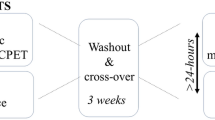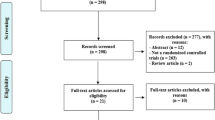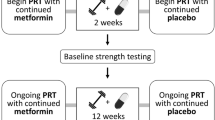Abstract
The CA-repeat polymorphism in the insulin-like growth factor 1 (IGF1) gene promoter region has been associated with strength and circulating IGF-I protein levels. The purpose of the study was to determine if the IGF1 CA-repeat polymorphism influences muscle power at baseline and in response to ST in older adults. Knee extensor peak power (PP) was measured at 50, 60, and 70% of 1-RM strength before and after 10 weeks of unilateral knee extensor ST in older adults, aged 50–85 years, to determine the changes in absolute and relative PP with ST. Subjects (N = 114) were genotyped for the IGF1 CA-repeat polymorphism and grouped as homozygous for the 192 allele, heterozygous, or non-carriers of the 192 allele. The 192 homozygotes had significantly lower baseline PP at 50, 60, and 70% of 1-RM strength than the non-carriers when age, sex, and baseline fat-free mass were covaried (all P < 0.05). This same relationship was observed when the highest PP within these ranges was compared (e.g., 317.6 ± 13.5 for 192 homozygotes and 380.2 ± 16.3 for non-carriers of the 192 allele, P < 0.05). Both absolute and relative PP increased significantly with ST in all genotype groups as expected, but there were no significant relationships among IGF1 genotypes and any of the PP changes. Despite a significant relationship between IGF1 genotype and knee extensor peak power at baseline, IGF1 genotype does not appear to influence changes in knee extensor peak power with ST.
Similar content being viewed by others
References
Allen NE, Davey GK, Key TJ, Zhang S, Narod SA (2002) Serum insulin-like growth factor I (IGF-I) concentration in men is not associated with the cytosine–adenosine repeat polymorphism of the IGF-I gene. Cancer Epidemiol Biomarkers Prev 11(3):319–320
Bamman MM, Petrella JK, Kim JS, Mayhew DL, Cross JM (2007) Cluster analysis tests the importance of myogenic gene expression during myofiber hypertrophy in humans. J Appl Physiol 102(6):2232–2239
Barbieri M, Ferrucci L, Ragno E, Corsi A, Bandinelli S, Bonafe M, Olivieri F, Giovagnetti S, Franceschi C, Guralnik JM, Paolisso G (2003) Chronic inflammation and the effect of IGF-I on muscle strength and power in older persons. Am J Physiol Endocrinol Metab 284(3):E481–E487
Berrigan D, Potischman N, Dodd KW, Hursting SD, Lavigne J, Barrett JC, Ballard-Barbash R (2009) Race/ethnic variation in serum levels of IGF-I and IGFBP-3 in US adults. Growth Horm IGF Res 19(2):146–155
Borst SE, Lowenthal DT (1997) Role of IGF-I in muscular atrophy of aging. Endocrine 7(1):61–63
Buchner DM, Cress ME, de Lateur BJ, Wagner EH (1993) Variability in the effect of strength training on skeletal muscle strength in older adults. Facts Res Gerontol 7:143–153
Callahan D, Phillips E, Carabello R, Frontera WR, Fielding RA (2007) Assessment of lower extremity muscle power in functionally-limited elders. Aging Clin Exp Res 19(3):194–199
Calvo M, Rodas G, Vallejo M, Estruch A, Arcas A, Javierre C, Viscor G, Ventura JL (2002) Heritability of explosive power and anaerobic capacity in humans. Eur J Appl Physiol 86(3):218–225
Cappola AR, Bandeen-Roche K, Wand GS, Volpato S, Fried LP (2001) Association of IGF-I levels with muscle strength and mobility in older women. J Clin Endocrinol Metab 86(9):4139–4146
Caroni P, Grandes P (1990) Nerve sprouting in innervated adult skeletal muscle induced by exposure to elevated levels of insulin-like growth factors. J Cell Biol 110(4):1307–1317
Chagnon YC, Rice T, Perusse L, Borecki IB, Ho-Kim MA, Lacaille M, Pare C, Bouchard L, Gagnon J, Leon AS, Skinner JS, Wilmore JH, Rao DC, Bouchard C (2001) Genomic scan for genes affecting body composition before and after training in Caucasians from HERITAGE. J Appl Physiol 90(5):1777–1787
Cuoco A, Callahan DM, Sayers S, Frontera WR, Bean J, Fielding RA (2004) Impact of muscle power and force on gait speed in disabled older men and women. J Gerontol A Biol Sci Med Sci 59(11):1200–1206
DeLellis K, Ingles S, Kolonel L, Kean-Cowdin R, Henderson B, Stanczyk F, Probst-Hensch NM (2003) IGF1 genotype, mean plasma level and breast cancer risk in the Hawaii/Los Angeles multiethnic cohort. Br J Cancer 88(2):277–282
Delmonico MJ, Kostek MC, Doldo NA, Hand BD, Bailey JA, Rabon-Stith KM, Conway JM, Carignan CR, Lang J, Hurley BF (2005) Effects of moderate-velocity strength training on peak muscle power and movement velocity: do women respond differently than men? J Appl Physiol 99(5):1712–1718
Delmonico MJ, Kostek MC, Doldo NA, Hand BD, Walsh S, Conway JM, Carignan CR, Roth SM, Hurley BF (2007) Alpha-actinin-3 (ACTN3) R577X polymorphism influences knee extensor peak power response to strength training in older men and women. J Gerontol A Biol Sci Med Sci 62(2):206–212
Dennis RA, Zhu H, Kortebein PM, Bush HM, Harvey JF, Sullivan DH, Peterson CA (2009) Muscle expression of genes associated with inflammation, growth, and remodeling is strongly correlated in older adults with resistance training outcomes. Physiol Genomics 38(2):169–175
Doldo NA, Delmonico MJ, Bailey JA, Hand BD, Kostek MC, Rabon-Stith KM, Menon KS, Conway JM, Carignan CR, Hurley BF (2006) Muscle-power quality: does sex or race affect movement velocity in older adults? J Aging Phys Act 14(4):411–422
Fiatarone MA, O’Neill EF, Ryan ND, Clements KM, Solares GR, Nelson ME, Roberts SB, Kehayias JJ, Lipsitz LA, Evans WJ (1994) Exercise training and nutritional supplementation for physical frailty in very elderly people. N Engl J Med 330(25):1769–1775
Fielding RA, LeBrasseur NK, Cuoco A, Bean J, Mizer K, Fiatarone Singh MA (2002) High-velocity resistance training increases skeletal muscle peak power in older women. J Am Geriatr Soc 50(4):655–662
Giovannini S, Marzetti E, Borst SE, Leeuwenburgh C (2008) Modulation of GH/IGF-1 axis: potential strategies to counteract sarcopenia in older adults. Mech Ageing Dev 129(10):593–601
Gonzalez E, Messi ML, Zheng Z, Delbono O (2003) Insulin-like growth factor-1 prevents age-related decrease in specific force and intracellular Ca2+ in single intact muscle fibres from transgenic mice. J Physiol 552(Pt 3):833–844
Grounds MD (2002) Reasons for the degeneration of ageing skeletal muscle: a central role for IGF-1 signalling. Biogerontology 3(1–2):19–24
Hagberg JM, Rankinen T, Loos RJ, Perusse L, Roth SM, Wolfarth B, Bouchard C (2011) Advances in exercise, fitness, and performance genomics in 2010. Med Sci Sports Exerc 43(5):743–752
Hameed M, Lange KH, Andersen JL, Schjerling P, Kjaer M, Harridge SD, Goldspink G (2004) The effect of recombinant human growth hormone and resistance training on IGF-I mRNA expression in the muscles of elderly men. J Physiol 555(Pt 1):231–240
Hand BD, Kostek MC, Ferrell RE, Delmonico MJ, Douglass LW, Roth SM, Hagberg JM, Hurley BF (2007) Influence of promoter region variants of insulin-like growth factor pathway genes on the strength-training response of muscle phenotypes in older adults. J Appl Physiol 103(5):1678–1687
Hanson ED, Ludlow AT, Sheaff AK, Park J, Roth SM (2010) ACTN3 genotype does not influence muscle power. Int J Sports Med 31(11):834–838
Harrela M, Koistinen H, Kaprio J, Lehtovirta M, Tuomilehto J, Eriksson J, Toivanen L, Koskenvuo M, Leinonen P, Koistinen R, Seppala M (1996) Genetic and environmental components of interindividual variation in circulating levels of IGF-I, IGF-II, IGFBP-1, and IGFBP-3. J Clin Invest 98(11):2612–2615
Heckman CJ, Sandercock TG (1996) From motor unit to whole muscle properties during locomotor movements. Exerc Sport Sci Rev 24:109–133
Hong Y, Pedersen NL, Brismar K, Hall K, and de FU (1996) Quantitative genetic analyses of insulin-like growth factor I (IGF-I), IGF-binding protein-1, and insulin levels in middle-aged and elderly twins. J Clin Endocrinol Metab 81(5):1791–1797
Huygens W, Thomis MA, Peeters MW, Vlietinck RF, Beunen GP (2004) Determinants and upper-limit heritabilities of skeletal muscle mass and strength. Can J Appl Physiol 29(2):186–200
Ivey FM, Roth SM, Ferrell RE, Tracy BL, Lemmer JT, Hurlbut DE, Martel GF, Siegel EL, Fozard JL, Jeffrey ME, Fleg JL, Hurley BF (2000a) Effects of age, gender, and myostatin genotype on the hypertrophic response to heavy resistance strength training. J Gerontol A Biol Sci Med Sci 55(11):M641–M648
Ivey FM, Tracy BL, Lemmer JT, NessAiver M, Metter EJ, Fozard JL, Hurley BF (2000b) Effects of strength training and detraining on muscle quality: age and gender comparisons. J Gerontol A Biol Sci Med Sci 55(3):B152–B157
Jozsi AC, Campbell WW, Joseph L, Davey SL, Evans WJ (1999) Changes in power with resistance training in older and younger men and women. J Gerontol A Biol Sci Med Sci 54(11):M591–M596
Kato I, Eastham J, Li B, Smith M, Yu H (2003) Genotype–phenotype analysis for the polymorphic CA repeat in the insulin-like growth factor-I (IGF-I) gene. Eur J Epidemiol 18(3):203–209
Kostek MC, Delmonico MJ, Reichel JB, Roth SM, Douglass L, Ferrell RE, Hurley BF (2005) Muscle strength response to strength training is influenced by insulin-like growth factor 1 genotype in older adults. J Appl Physiol 98(6):2147–2154
Kostka T (2005) Quadriceps maximal power and optimal shortening velocity in 335 men aged 23–88 years. Eur J Appl Physiol 95(2–3):140–145
Kostka T, Arsac LM, Patricot MC, Berthouze SE, Lacour JR, Bonnefoy M (2000) Leg extensor power and dehydroepiandrosterone sulfate, insulin-like growth factor-I and testosterone in healthy active elderly people. Eur J Appl Physiol 82(1–2):83–90
Lemmer JT, Hurlbut DE, Martel GF, Tracy BL, Ivey FM, Metter EJ, Fozard JL, Fleg JL, Hurley BF (2000) Age and gender responses to strength training and detraining. Med Sci Sports Exerc 32(8):1505–1512
Lindle RS, Metter EJ, Lynch NA, Fleg JL, Fozard JL, Tobin J, Roy TA, Hurley BF (1997) Age and gender comparisons of muscle strength in 654 women and men aged 20–93 yr. J Appl CPhysiol 83(5):1581–1587
Marsh AP, Miller ME, Saikin AM, Rejeski WJ, Hu N, Lauretani F, Bandinelli S, Guralnik JM, Ferrucci L (2006) Lower extremity strength and power are associated with 400-meter walk time in older adults: The InCHIANTI study. J Gerontol A Biol Sci Med Sci 61(11):1186–1193
McCarthy TL, Ji C, Shu H, Casinghino S, Crothers K, Rotwein P, Centrella M (1997) 17beta-estradiol potently suppresses cAMP-induced insulin-like growth factor-I gene activation in primary rat osteoblast cultures. J Biol Chem 272(29):18132–18139
Melnyk JA, Rogers MA, Hurley BF (2009) Effects of strength training and detraining on regional muscle in young and older men and women. Eur J Appl Physiol 105(6):929–938
Messi ML, Delbono O (2003) Target-derived trophic effect on skeletal muscle innervation in senescent mice. J Neurosci 23(4):1351–1359
Newman AB, Haggerty CL, Goodpaster B, Harris T, Kritchevsky S, Nevitt M, Miles TP, Visser M (2003) Strength and muscle quality in a well-functioning cohort of older adults: The Health, Aging and Body Composition Study. J Am Geriatr Soc 51(3):323–330
Niino N, Kozakai R, Eto M (2003) Epidemiology of falls among community-dwelling elderly people. Nippon Ronen Igakkai Zasshi 40(5):484–486
Philippou A, Halapas A, Maridaki M, Koutsilieris M (2007) Type I insulin-like growth factor receptor signaling in skeletal muscle regeneration and hypertrophy. J Musculoskelet Neuronal Interact 7(3):208–218
Puthoff ML, Nielsen DH (2007) Relationships among impairments in lower-extremity strength and power, functional limitations, and disability in older adults. Phys Ther 87(10):1334–1347
Rabinovsky ED, Gelir E, Gelir S, Lui H, Kattash M, DeMayo FJ, Shenaq SM, Schwartz RJ (2003) Targeted expression of IGF-1 transgene to skeletal muscle accelerates muscle and motor neuron regeneration. FASEB J 17(1):53–55
Raj IS, Bird SR, Shield AJ (2010) Aging and the force–velocity relationship of muscles. Exp Gerontol 45(2):81–90
Rantanen T, Guralnik JM, Leveille S, Izmirlian G, Hirsch R, Simonsick E, Ling S, Fried LP (1998) Racial differences in muscle strength in disabled older women. J Gerontol A Biol Sci Med Sci 53(5):B355–B361
Reid KF, Naumova EN, Carabello RJ, Phillips EM, Fielding RA (2008) Lower extremity muscle mass predicts functional performance in mobility-limited elders. J Nutr Health Aging 12(7):493–498
Rietveld I, Janssen JA, Hofman A, Pols HA, van Duijn CM, Lamberts SW (2003) A polymorphism in the IGF-I gene influences the age-related decline in circulating total IGF-I levels. Eur J Endocrinol 148(2):171–175
Rivadeneira F, Houwing-Duistermaat JJ, Beck TJ, Janssen JA, Hofman A, Pols HA, van Duijn CM, Uitterlinden AG (2004) The influence of an insulin-like growth factor I gene promoter polymorphism on hip bone geometry and the risk of nonvertebral fracture in the elderly: the Rotterdam Study. J Bone Miner Res 19(8):1280–1290
Rosen CJ, Kurland ES, Vereault D, Adler RA, Rackoff PJ, Craig WY, Witte S, Rogers J, Bilezikian JP (1998) Association between serum insulin growth factor-I (IGF-I) and a simple sequence repeat in IGF-I gene: implications for genetic studies of bone mineral density. J Clin Endocrinol Metab 83(7):2286–2290
Schildkraut JM, mark-Wahnefried W, Wenham RM, Grubber J, Jeffreys AS, Grambow SC, Marks JR, Moorman PG, Hoyo C, Ali S, Walther PJ (2005) IGF1 (CA)19 repeat and IGFBP3–202 A/C genotypes and the risk of prostate cancer in black and white men. Cancer Epidemiol Biomarkers Prev 14(2):403–408
Schutte AE, Huisman HW, van Rooyen JM, Malan L, Malan NT, Fourie CM, Louw R, van der Westhuizen FH, Schutte R (2010) A significant decline in IGF-I may predispose young Africans to subsequent cardiometabolic vulnerability. J Clin Endocrinol Metab 95(5):2503–2507
Singh MA, Ding W, Manfredi TJ, Solares GS, O’Neill EF, Clements KM, Ryan ND, Kehayias JJ, Fielding RA, Evans WJ (1999) Insulin-like growth factor I in skeletal muscle after weight-lifting exercise in frail elders. Am J Physiol 277(1 Pt 1):E135–E143
Skelton DA, Greig CA, Davies JM, Young A (1994) Strength, power and related functional ability of healthy people aged 65–89 years. Age Ageing 23(5):371–377
Skelton DA, Young A, Greig CA, Malbut KE (1995) Effects of resistance training on strength, power, and selected functional abilities of women aged 75 and older. J Am Geriatr Soc 43(10):1081–1087
Sun G, Gagnon J, Chagnon YC, Perusse L, Despres JP, Leon AS, Wilmore JH, Skinner JS, Borecki I, Rao DC, Bouchard C (1999) Association and linkage between an insulin-like growth factor-1 gene polymorphism and fat free mass in the HERITAGE Family Study. Int J Obes Relat Metab Disord 23(9):929–935
Tiainen K, Sipila S, Alen M, Heikkinen E, Kaprio J, Koskenvuo M, Tolvanen A, Pajala S, Rantanen T (2005) Shared genetic and environmental effects on strength and power in older female twins. Med Sci Sports Exerc 37(1):72–78
Tracy BL, Ivey FM, Hurlbut D, Martel GF, Lemmer JT, Siegel EL, Metter EJ, Fozard JL, Fleg JL, Hurley BF (1999) Muscle quality. II. Effects of strength training in 65- to 75-yr-old men and women. J Appl Physiol 86(1):195–201
Tracy BL, Ivey FM, Jeffrey ME, Fleg JL, Siegel EL, Hurley BF (2003) A more efficient magnetic resonance imaging-based strategy for measuring quadriceps muscle volume. Med Sci Sports Exerc 35(3):425–433
Vaessen N, Heutink P, Janssen JA, Witteman JC, Testers L, Hofman A, Lamberts SW, Oostra BA, Pols HA, van Duijn CM (2001) A polymorphism in the gene for IGF-I: functional properties and risk for type 2 diabetes and myocardial infarction. Diabetes 50(3):637–642
Visser M, Kritchevsky SB, Goodpaster BH, Newman AB, Nevitt M, Stamm E, Harris TB (2002) Leg muscle mass and composition in relation to lower extremity performance in men and women aged 70 to 79: the health, aging and body composition study. J Am Geriatr Soc 50(5):897–904
Wang ZM, Messi ML, Delbono O (2002) Sustained overexpression of IGF-1 prevents age-dependent decrease in charge movement and intracellular Ca(2+) in mouse skeletal muscle. Biophys J 82(3):1338–1344
Winter DA (1989) Biomechanics of normal and pathological gait: implications for understanding human locomotor control. J Mot Behav 21(4):337–355
Wretenberg P, Arborelius UP (1994) Power and Work Produced in Different Leg Muscle Groups When Rising from A Chair. Eur J Appl Physiol Occupational Physiol 68(5):413–417
Yang H, Alnaqeeb M, Simpson H, Goldspink G (1997) Changes in muscle fibre type, muscle mass and IGF-I gene expression in rabbit skeletal muscle subjected to stretch. J Anat 190 (Pt 4):613–622
Acknowledgments
This study was partially supported by grant funds from the National Institutes of Health (AG021500 and AG022791).
Conflict of interest
There were no conflicts of interest for any of the authors.
Author information
Authors and Affiliations
Corresponding author
Additional information
Communicated by William J. Kraemer.
Rights and permissions
About this article
Cite this article
Sood, S., Hanson, E.D., Delmonico, M.J. et al. Does insulin-like growth factor 1 genotype influence muscle power response to strength training in older men and women?. Eur J Appl Physiol 112, 743–753 (2012). https://doi.org/10.1007/s00421-011-2028-7
Received:
Accepted:
Published:
Issue Date:
DOI: https://doi.org/10.1007/s00421-011-2028-7




